“Global Internet of Things Analytics Market to reach a market value of 206.8 Billion by 2031 growing at a CAGR of 27.2%”
The Global Internet of Things Analytics Market size is expected to reach $206.8 billion by 2031, rising at a market growth of 27.2% CAGR during the forecast period.
The North America region witnessed 39% revenue share in this market in 2023. This dominance can be attributed to the early adoption of advanced technologies, significant investment in IoT infrastructure, and a robust ecosystem of technology companies. The presence of major tech giants and innovative startups in the United States and Canada has fostered an environment conducive to the rapid development and deployment of IoT analytics solutions.
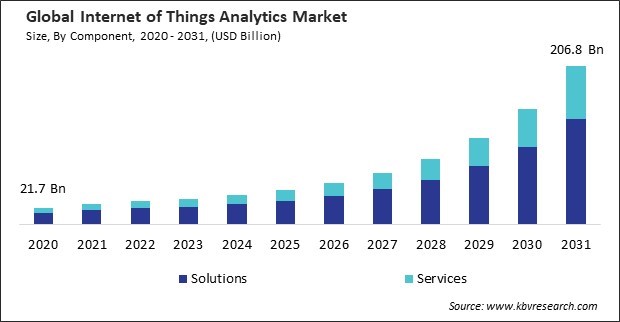
The major strategies followed by the market participants are Partnerships as the key developmental strategy to keep pace with the changing demands of end users. For instance, In September, 2024, Amazon and Anthropic have formed a strategic collaboration, with Anthropic choosing AWS as its primary cloud provider. This partnership will utilize AWS Trainium and Inferentia chips to develop foundation models, enhancing accessibility and customization for AWS customers via Amazon Bedrock. Moreover, In August, 2024, Oracle and AT&T have partnered to enhance 5G connectivity, focusing on IoT applications. By integrating AT&T's IoT network APIs into Oracle's Enterprise Communications Platform, the collaboration aims to provide users with a streamlined interface for managing IoT devices securely in various industries.
Based on the Analysis presented in the KBV Cardinal matrix; Microsoft Corporation and Google LLC are the forerunners in the Internet of Things Analytics Market. In October, 2023, Microsoft Corporation and Rockwell Automation, Inc. are expanding their partnership to integrate Azure OpenAI Service into FactoryTalk Design Studio, enhancing industrial automation design. This collaboration aims to improve productivity, streamline processes, and address skilled labor shortages in the industry. Companies such as Amazon Web Services, Inc., Accenture PLC and Hewlett Packard Enterprise Company are some of the key innovators in Internet of Things Analytics Market.
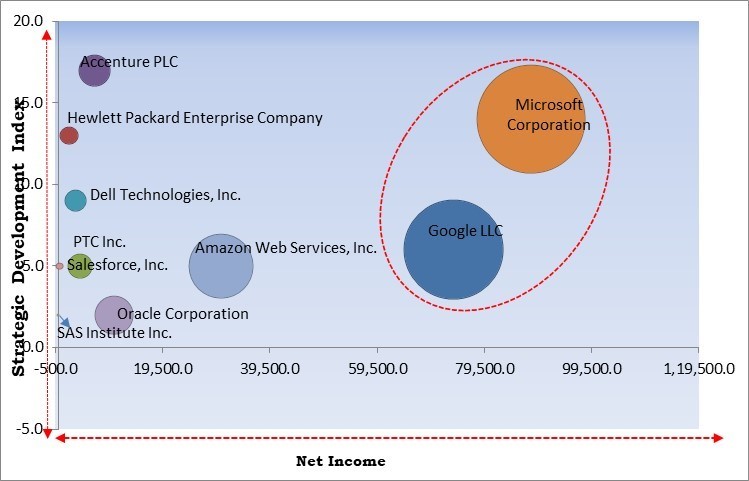
Organizations are often required to make swift decisions in dynamic environments. Real-time data insights enable decision-makers to act on the latest information without delay, allowing them to respond to emerging trends, potential risks, or operational issues almost instantly. This capability is crucial in manufacturing, healthcare, and logistics industries, where timely decisions can significantly impact efficiency and outcomes. Thus, the rising demand for real-time data insights propels the market's growth.
Additionally, One of the standout features of 5G technology is its ability to transmit data at unprecedented speeds. While 4G networks can deliver speeds of up to 100 Mbps, 5G can reach speeds exceeding 1 Gbps. This capability allows IoT devices to instantly send and receive vast amounts of data. With faster data transmission, organizations can utilize IoT analytics in previously impractical ways. In conclusion, enhanced connectivity and 5G implementation drive the market's growth.
Deploying IoT solutions requires specialized sensors and devices to collect data across various metrics (e.g., temperature, pressure, movement). These devices often must be installed across multiple locations or assets, leading to high capital expenditure. IoT systems require robust networking infrastructure to enable devices to connect and communicate. Thus, high initial investment and operating costs hamper the market's growth.
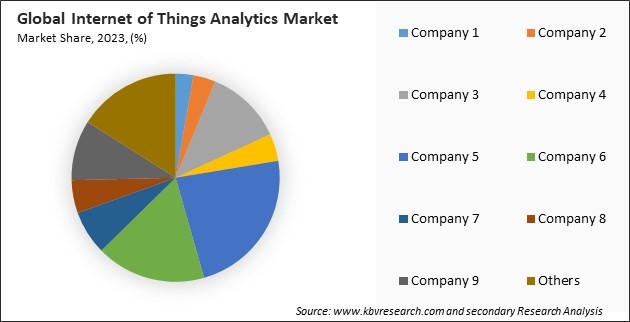
The leading players in the market are competing with diverse innovative offerings to remain competitive in the market. The above illustration shows the percentage of revenue shared by some of the leading companies in the market. The leading players of the market are adopting various strategies in order to cater demand coming from the different industries. The key developmental strategies in the market are Partnerships & Collaborations.
On the basis of organization size, the internet of things analytics market is segmented into small & medium enterprises (SMEs) and large enterprises. The SMEs segment recorded 32% revenue share in this market in 2023. This indicates a significant adoption of IoT analytics solutions among smaller organizations, increasingly leveraging these technologies to enhance operational efficiency, improve customer engagement, and gain competitive advantages.
Based on deployment, the internet of things analytics market is categorized into on-premises and cloud. The on-premise segment witnessed 34% revenue share in this market in 2023. Many large enterprises and organizations with strict data security and compliance requirements prefer on-premises solutions to maintain control over their data and systems. On-premises deployments allow these organizations to customize their IoT analytics infrastructure to meet specific operational needs while ensuring enhanced security measures.
Based on type, the internet of things analytics market is divided into descriptive analytics, diagnostic analytics, predictive analytics, and prescriptive analytics. The descriptive analytics segment attained 29% revenue share in this market in 2023. This segment is essential as it summarizes historical data, helping organizations understand past performance and trends. Descriptive analytics lays the foundation for further analysis and decision-making processes within various IoT applications by providing insights into what has happened.
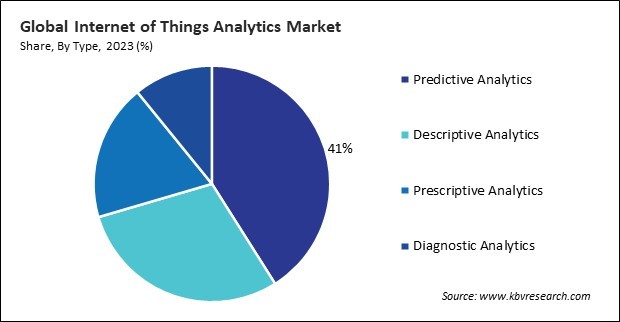
Based on component, the internet of things analytics market is divided into solution and services. The services segment attained 30% revenue share in this market in 2023. Companies adopting IoT solutions often require specialized support and expertise to optimize their analytics processes and ensure effective implementation. The notable revenue contribution from the services segment indicates a rising trend among organizations seeking ongoing assistance and guidance to navigate the complexities of IoT analytics.
By application, the internet of things analytics market is divided into energy management, predictive maintenance, asset management, inventory management, remote monitoring, and others. In 2023, the remote monitoring held 22% revenue share in this market. This application enables organizations to monitor operations, systems, and devices from a distance, providing real-time visibility and control over processes. Remote monitoring is particularly valuable in sectors like healthcare, agriculture, and smart cities, where continuous oversight is essential for maintaining efficiency and safety.
By end use, the internet of things analytics market is segmented into manufacturing, energy & utilities, retail & e-commerce, healthcare & life sciences, transportation & logistics, IT & telecom, and others. In 2023, the transportation & logistics segment acquired 17% revenue share in this market. This application area greatly benefits from real-time vehicle performance data, traffic conditions, and supply chain logistics. IoT analytics facilitates better route planning, fleet management, and inventory tracking, enhancing operational efficiencies and reducing costs.
Free Valuable Insights: Global Internet of Things Analytics Market size to reach USD 206.8 Billion by 2031
Region-wise, the internet of things analytics market is analyzed across North America, Europe, Asia Pacific, and LAMEA. In 2023, the Europe region generated 29% revenue share in this market. European countries invest heavily in IoT solutions to support their digital transformation agendas. The emphasis on smart cities, industrial automation, and sustainable practices has fuelled the demand for IoT analytics across various sectors, including manufacturing, healthcare, and transportation.
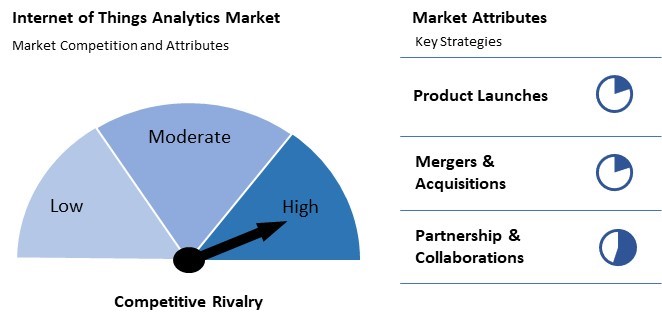
The Internet of Things (IoT) Analytics Market, excluding top players, is highly competitive, with numerous regional and niche firms vying for attention. Smaller players focus on specific industries or offer unique analytics tools tailored to specialized IoT applications. Innovation in predictive analytics, edge computing, and integration capabilities enables these companies to capture market segments and meet evolving client demands efficiently.
| Report Attribute | Details |
|---|---|
| Market size value in 2023 | USD 34.1 Billion |
| Market size forecast in 2031 | USD 206.8 Billion |
| Base Year | 2023 |
| Historical Period | 2020 to 2022 |
| Forecast Period | 2024 to 2031 |
| Revenue Growth Rate | CAGR of 27.2% from 2024 to 2031 |
| Number of Pages | 432 |
| Tables | 673 |
| Report coverage | Market Trends, Revenue Estimation and Forecast, Segmentation Analysis, Regional and Country Breakdown, Competitive Landscape, Market Share Analysis, Porter’s 5 Forces Analysis, Company Profiling, Companies Strategic Developments, SWOT Analysis, Winning Imperatives |
| Segments covered | Component, Organization Size, Deployment, Type, Application, End Use, Region |
| Country scope |
|
| Companies Included | Accenture PLC, Dell Technologies, Inc., Google LLC, Hewlett Packard Enterprise Company, Amazon Web Services, Inc. (Amazon.com, Inc.), Microsoft Corporation, Oracle Corporation, PTC Inc., Salesforce, Inc., SAS Institute Inc. |
By Component
By End Use
By Organization Size
By Deployment
By Type
By Application
By Geography
This Market size is expected to reach $206.8 billion by 2031.
Rising Demand For Real-Time Data Insights are driving the Market in coming years, however, High Initial Investment And Operating Costs restraints the growth of the Market.
Accenture PLC, Dell Technologies, Inc., Google LLC, Hewlett Packard Enterprise Company, Amazon Web Services, Inc. (Amazon.com, Inc.), Microsoft Corporation, Oracle Corporation, PTC Inc., Salesforce, Inc., SAS Institute Inc.
The expected CAGR of this Market is 27.2% from 2024 to 2031.
The Solutions segment generated the maximum revenue in the Market by Component in 2023, thereby, achieving a market value of $138.1 billion by 2031.
The North America region dominated the Market by Region in 2023, and would continue to be a dominant market till 2031; thereby, achieving a market value of $76.5 billion by 2031.
Our team of dedicated experts can provide you with attractive expansion opportunities for your business.
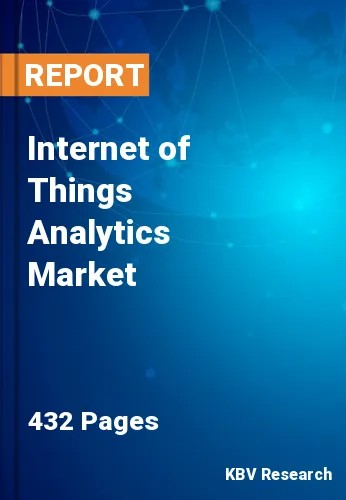
 Drivers
Drivers
 Restraints
Restraints
 Opportunities
Opportunities
 Challenges
Challenges
